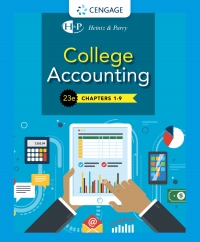Question
Question 1) GlynnCo, a 20X1 start-up that uses the periodic method and weighted-average costing, makes the following merchandise purchases: 20X1 Units Unit cost March 400
Question 1) GlynnCo, a 20X1 start-up that uses the periodic method and weighted-average costing, makes the following merchandise purchases:
| 20X1 | Units | Unit cost |
| March | 400 | $3.00 |
| August | 600 | $3.50 |
| 20X2 |
|
|
| February | 550 | $4.00 |
| October | 100 | $5.05 |
At the end of 20X1, there are 350 units in ending inventory. If, in 20X2, GlynnCo sells 800 units, what is the 20X2 ending inventory?
| $777.50 | ||
| $772 | ||
| $768.50 | ||
| $832.31 | ||
| $905 |
Question 2) FiCo, which uses the periodic method and weighted-average costing, shows the following data:
| Units | Unit Cost | |
| Beginning Inventory | 96 | $2.00 |
| January 25 purchase | 220 | $2.25 |
| March 25 purchase | 544 | $2.50 |
| August 16 purchase | 480 | $2.80 |
| November 26 purchase | 160 | $2.90 |
If FiCos year-end physical account shows 150 units on hand, FiCos balance sheet as of December 31 will show ending inventory of:
| $373.50 | ||
| $58.37 | ||
| $385.50 | ||
| $313.50 | ||
| $435 |
Question 3) ClackCo, a 20X1 start-up, uses the periodic method and LIFO costing. The company purchases merchandise as follows:
| 20X1 | Units | Unit cost |
| March | 450 | $3.00 |
| August | 650 | $3.50 |
| 20X2 |
|
|
| February | 550 | $4.00 |
| October | 250 | $5.00 |
In 20X1, ClackCo sells 750 units. At year-end 20X2, there are 500 units on hand. ClackCo's balance sheet as of December 31, 20X2, will show ending inventory of:
$2,850
$1,525
$2,350
$2,250
$1,650
Question 4) Alison Inc., which uses the perpetual method and moving-average costing, shows the following activity for January:
| Quantity | Unit Cost | ||
| January 1 | beginning inventory | 140 | $6 |
| January 8 | sale | 100 | |
| January 15 | purchase | 60 | $5 |
| January 20 | sale | 80 | |
| January 25 | purchase | 180 | $4.50 |
What is the value of the ending inventory for the month?
| $1,026 | ||
| $1,033.33 | ||
| $1,123.80 | ||
| $900 | ||
| $918 |
Question 5) Under LIFO costing:
| Ending inventory may include items from the earliest and most recent purchases. | ||
| Ending inventory is always the items purchased earliest. | ||
| Ending inventory is always the most recently purchased items. |
PLEASE ANSWER ONLY IF YOU CAN ANSWER ALL OF THESE, DON'T ANSWER ONLY FIRST AND WRITE "IT IS THE POLICY OF CHEGG".
I know the policy and you should know that there are teachers on Chegg who solve all the questions, so spare this for them don't attempt.
I will upvote you if all the questions will be correct.
Step by Step Solution
There are 3 Steps involved in it
Step: 1

Get Instant Access to Expert-Tailored Solutions
See step-by-step solutions with expert insights and AI powered tools for academic success
Step: 2

Step: 3

Ace Your Homework with AI
Get the answers you need in no time with our AI-driven, step-by-step assistance
Get Started


